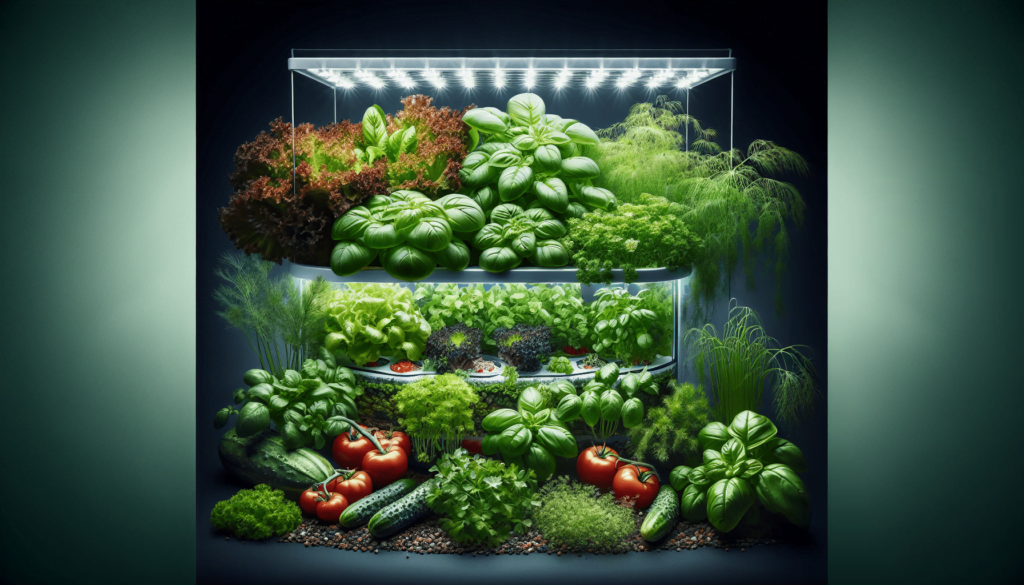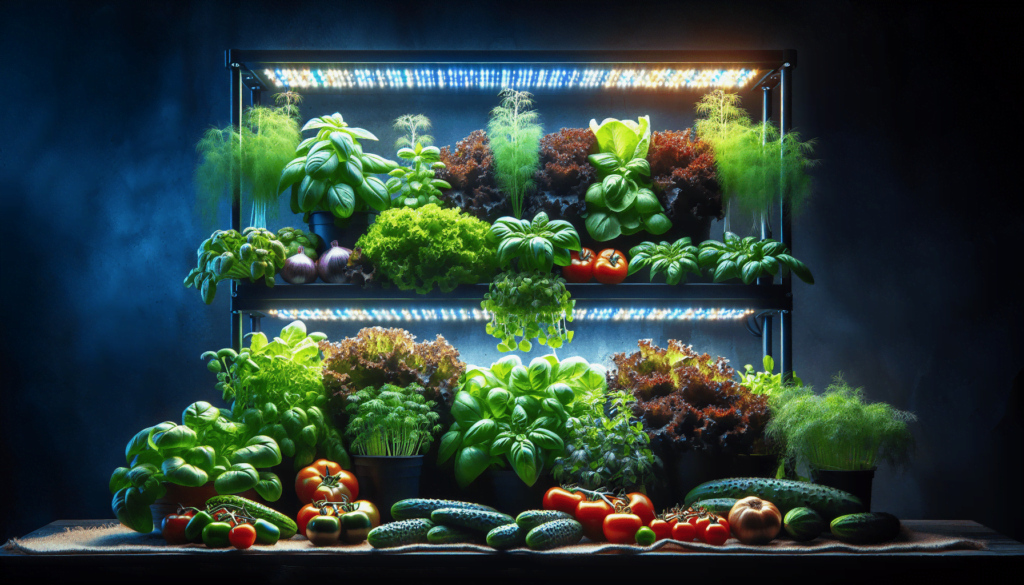Throwing open the windows to the wonderful world of hydroponics might feel a little daunting at first, especially when it comes to choosing the right plants. It’s time to demystify this confusion and guide you gently down the green path. In this article, “The Best Vegetables and Herbs for Your Home Hydroponics System”, we unfold a myriad of options for you, highlighting those that thrive best in a home hydroponics system. From crisp lettuce to fragrant herbs, we’re making your first steps into this fascinating realm truly effortless and enjoyable!

Understanding Hydroponics Systems
Basic principles of hydroponics
In the world of gardening, hydroponics is an exciting technology that allows us to grow our favorite plants without needing any soil. Using a nutrient-rich water solution with inert media (like Rockwool or Perlite) supporting the plant roots, we inspire growth in a highly controlled environment. This delivers the exact nutrients the plants need, leading to optimized growth and fruit production.
The benefits of hydroponics for home gardening
Adapting hydroponics for home gardening brings plenty of advantages to us. Space is hyper-efficiently utilized, meaning we can grow more in smaller areas. Plants are usually healthier because disease and pest transmission is limited, and there’s typically better control over nutrients and pH levels. And one of the biggest perks for us gardeners is that it eliminates the need for weeding!
Different types of hydroponics systems
There are several hydroponics systems for us to choose from, each with its unique benefits based on our gardening goals. The Deep Water Culture (DWC), Ebb and Flow, Nutrient Film Technique (NFT), and Aeroponics are among the popular ones. We need to consider factors like the specific needs of the plants, our budget, and the available space when choosing a hydroponic system.
Key Factors to Consider When Choosing Plants for Hydroponics
Understanding crop types: fruiting, leafy, and root crops
When we select plants for our hydroponics system, we need to pay attention to crop types. Fruiting crops like tomatoes and peppers seek lots of light and higher nutrient levels, while leafy crops such as lettuce and kale are less demanding. Root crops like radishes and beets can be a challenge but are definitely doable with the right knowledge and techniques.
The growth cycle and maturity rate of plants
Some plants take longer to mature than others. For example, peppers can take 2 to 3 months, while lettuce may only take a month. The timing and growth cycles should be considered to ensure continuous harvests and efficient use of the hydroponic system.
Nutrient requirements of individual plants
Different plants have unique nutrient needs, which greatly affects their growth and output. Tomatoes and peppers require high levels of potassium for fruit development, while leafy greens thrive with more nitrogen. It’s crucial for our plants’ success to understand nutritional needs and adjust our nutrient solutions accordingly.
Best Leafy Greens for Hydroponics
Lettuce: Features and Growth Requirements
Lettuce is a favorite for beginners as it’s highly adaptable and grows well in most hydroponic systems. It prefers cooler conditions, with a temperature range of 60 to 70 degrees Fahrenheit proving optimal. Lighting is also important, with the lettuce requiring about 10 to 14 hours of light per day.
Spinach: Features and Growth Requirements
Spinach is another excellent choice for your hydroponic garden, as it thrives in the controlled environment. Spinach prefers a slightly acidic pH and cooler temperatures, similar to lettuce. A nutrient formula high in Nitrogen will help it develop those nutrient-rich, strong, and tasty leaves.
Chard: Features and Growth Requirements
Chard is a colorful and nutritious addition to your hydroponics garden. It thrives under the same conditions as spinach and lettuce but tends to take a little longer to mature. The leafy vegetable enjoys plenty of light and a nutrient solution rich in Nitrogen and Potassium.
Favorable Herbs for Hydroponics
Basil: Features and Growth Requirements
Basil enjoys higher temperatures and plenty of light, while also preferring a slightly acidic pH level. It grows very well in hydroponic systems, with DWC and NFT being particularly suitable.
Dill: Features and Growth Requirements
Dill is a low-maintenance, fast-growing herb that’s perfect for the hydroponic beginner. Pretty forgiving, it can withstand a range of pH levels, temperatures, and light conditions. However, it does enjoy plenty of space to spread out its feathery leaves and may require regular trimmings.
Mint: Features and Growth Requirements
Mint is an aggressive grower and can quickly take over your hydroponic system if left unchecked. However, it’s easy to grow, highly productive, and ideal for systems like DWC. Mint prefers moderately warm temperatures, indirect light, and a neutral pH level.

Optimal Fruiting Vegetables for Hydroponics
Tomatoes: Features and Growth Requirements
Tomatoes require ample light, high levels of nutrients, and slightly acidic pH. They do well in warm conditions (between 70 and 75 degrees Fahrenheit) and appreciate systems like Ebb and Flow that facilitate good root oxygenation.
Peppers: Features and Growth Requirements
Like tomatoes, peppers are fruiting plants and require plenty of light, nutrients, and warmer temperatures to thrive. They’re a bit more sensitive to pH imbalances, and ideal levels should range between 5.8 and 6.2.
Cucumbers: Features and Growth Requirements
Cucumbers grow incredibly well hydroponically and produce an abundant harvest. They prefer lots of direct light, warm temperatures, and an average pH level slightly on the acidic side. Good air circulation is crucial for these plants to keep them healthy and productive.
Root Vegetables Suitable for Hydroponics
Radishes: Features and Growth Requirements
Among root crops, radishes are about the easiest to grow in hydroponic systems. They’re fast-growing and require a cooler temperature range, between 50-65F. Radishes need lower levels of light compared to other veggies, and should have a neutral pH for optimal growth.
Beets: Features and Growth Requirements
Beets require some more attention, as they’re slow growing and need a specific nutrient mixture focused on root development. The pH level for beets should be between 6.0 and 6.5, and they generally prefer cooler temperatures.
Carrots: Features and Growth Requirements
Carrots can be challenging for hydroponic beginners, but they’re certainly possible to grow with the right setup. They require cool temperatures, moderate light levels, and a nutrient solution encouraging root growth over foliage.
Hydroponic Salad Crops
Arugula: Features and Growth Requirements
Arugula is a peppery, leafy-green common in salad mixes. It grows rapidly in a cool climate and can be harvested in as few as 4 weeks. Arugula prefers a pH of around 6 and a cooler climate, making it suitable for hydroponic growth in less sunny places.
Kale: Features and Growth Requirements
Kale is a nutrient-dense superfood that’s capable of growing exceptionally well in hydroponic systems. This leafy green prefers a slightly acidic environment, with an ideal pH range of 5.5-6.5, and grows best in cool temperatures.
Collards: Features and Growth Requirements
Collard greens are Cold-tolerant and enjoys a pH range of 6.5 to 7.0. Collards are high-yielding, robust plants that can survive in a wide range of climates. However, they do especially well in full sun and cool climates.
Criteria for Selecting the Best Hybrids and Varieties
Important factors to consider when selecting plant varieties for hydroponics
When selecting plants for our hydroponic system, we need to consider factors such as their adaptability to hydroponic conditions, their growth cycles, their nutrient requirements, and their ease of maintenance.
Some popular hybrid and heirloom varieties for hydroponic gardening
Many successful hydroponic gardeners swear by certain varieties for optimum yield and flavor. For instance, “Black Seeded Simpson” and “Buttercrunch” are popular lettuce varieties; “Early Girl” and “Super Sweet 100” are favorite tomato types, and “Marketmore 76” cucumbers often get great reviews.
Sowing and Germinating Seeds for Hydroponics
Best practices for sowing seeds for hydroponics
Sowing seeds for hydroponics is a delicate process. We ensure we provide the right growing conditions including temperature, moisture, and light. Firstly, use specially designed plugs or use a good sterile seedling mix.
Different types of growing media
Growing media for hydroponics can be bewildering as we have many options. Rockwool, perlite, vermiculite, and coconut coir are some of the choices each offering different benefits based on our type of system and kinds of plants.
Conditions necessary for germination for different types of plants
Different plant species each require specific conditions for germination. Some need light to germinate, while others need darkness. Some require soaking before sowing, while others prefer to be directly sown. Refer to the individual seed packets for exact germination needs.
Maintenance Tips for Hydroponic Plants
Water quality and nutrient management
The key to thriving hydroponic plants lies in an optimal balance of water quality, nutrient levels, pH, and temperature. Always use clean water, preferably filtered or distilled, and regularly check the nutrient mix and pH.
Lighting needs for different types of plants
Maintaining proper lighting for our plants is crucial for those doing indoor gardening. The amount of light that plants require can vary, with fruiting plants generally needing more light than leafy ones.
Correct pH and temperature conditions for hydroponic plants
A stable pH level of around 5.5-6.5 is advised for your nutrient solution, although this can vary based on the exact plants in your setup. Temperature control is also important, with most plants thriving at temperatures between 65 and 75 degrees Fahrenheit.
Pest and disease management in hydroponic gardening
Hydroponics isn’t entirely immune to pests and diseases. Common hydroponic pests include aphids, spider mites, and whiteflies, while common diseases include root rot and powdery mildew. Keep a close watch on the plants, clean the systems regularly, and handle any outbreaks immediately and thoroughly.
Forum
Got something to share or a question to ask? Jump in and start a conversation! Whether it’s tips, advice, or just sharing your experiences, we’d love to hear from you. Don’t be shy—your input could inspire or help someone else!- This forum has 1 topic, and was last updated 10 months, 2 weeks ago by .
- Topic
- Voices
- Last Post
- You must be logged in to create new topics.


